小学英语重点句型语法总结与分析
小学三年级英语常用重点句型+语法知识总结
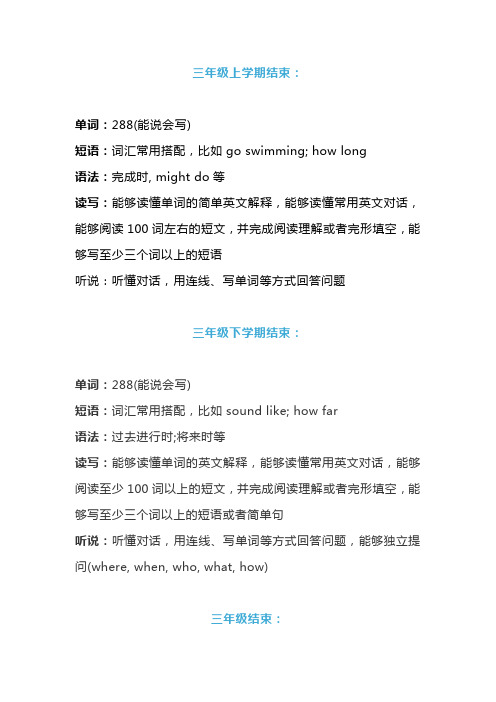
三年级上学期结束:单词:288(能说会写)短语:词汇常用搭配,比如go swimming; how long语法:完成时, might do等读写:能够读懂单词的简单英文解释,能够读懂常用英文对话,能够阅读100词左右的短文,并完成阅读理解或者完形填空,能够写至少三个词以上的短语听说:听懂对话,用连线、写单词等方式回答问题三年级下学期结束:单词:288(能说会写)短语:词汇常用搭配,比如sound like; how far语法:过去进行时;将来时等读写:能够读懂单词的英文解释,能够读懂常用英文对话,能够阅读至少100词以上的短文,并完成阅读理解或者完形填空,能够写至少三个词以上的短语或者简单句听说:听懂对话,用连线、写单词等方式回答问题,能够独立提问(where, when, who, what, how)三年级结束:背诵能力:轻松背诵100词以上短文或者对话读写:能够阅读100词以上文章,并书写3个单词词以上的英文答案听说:能够听懂简单的常用英文对话,能够使用where等疑问词独立提问小学三年级英语重点句型1. Hello!喂 Hi! 嗨2. Hello! I'm Wu Yifan. I'm from China.你好!我叫吴一凡。
我来自中国。
3. What's your name?你叫什么名字?4. My name's Chen Jie. 我的名字叫陈洁5. I have a pencil. 我有一只钢笔。
Me too.我也是。
6. Good morning.早上好Good afternoon.晚上好7. This is Miss White. 这是Miss White。
Nice to meet you. 很高兴认识你。
8. Where are you from?你来自哪里?I'm from America. 我来自美国。
9. Let's go to school.让我们一起去学校。
小学英语语法知识总结
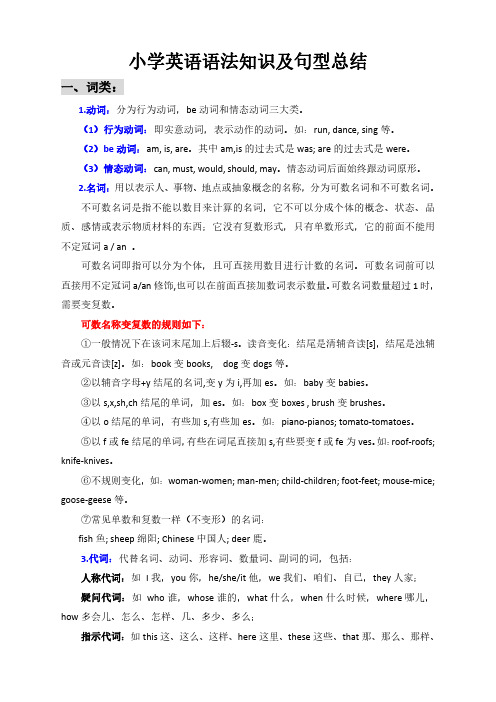
小学英语语法知识及句型总结一、词类:1.动词:分为行为动词,be动词和情态动词三大类。
(1)行为动词:即实意动词,表示动作的动词。
如:run,dance,sing等。
(2)be动词:am,is,are。
其中am,is的过去式是was;are的过去式是were。
(3)情态动词:can,must,would,should,may。
情态动词后面始终跟动词原形。
2.名词:用以表示人、事物、地点或抽象概念的名称,分为可数名词和不可数名词。
不可数名词是指不能以数目来计算的名词,它不可以分成个体的概念、状态、品质、感情或表示物质材料的东西;它没有复数形式,只有单数形式,它的前面不能用不定冠词a/an。
可数名词即指可以分为个体,且可直接用数目进行计数的名词。
可数名词前可以直接用不定冠词a/an修饰,也可以在前面直接加数词表示数量。
可数名词数量超过1时,需要变复数。
可数名称变复数的规则如下:①一般情况下在该词末尾加上后辍-s。
读音变化:结尾是清辅音读[s],结尾是浊辅音或元音读[z]。
如:book变books,dog变dogs等。
②以辅音字母+y结尾的名词,变y为i,再加es。
如:baby变babies。
③以s,x,sh,ch结尾的单词,加es。
如:box变boxes,brush变brushes。
④以o结尾的单词,有些加s,有些加es。
如:piano-pianos;tomato-tomatoes。
⑤以f或fe结尾的单词,有些在词尾直接加s,有些要变f或fe为ves。
如:roof-roofs; knife-knives。
⑥不规则变化,如:woman-women;man-men;child-children;foot-feet;mouse-mice; goose-geese等。
⑦常见单数和复数一样(不变形)的名词:fish鱼;sheep绵阳;Chinese中国人;deer鹿。
3.代词:代替名词、动词、形容词、数量词、副词的词,包括:人称代词:如I我,you你,he/she/it他,we我们、咱们、自己,they人家;疑问代词:如who谁,whose谁的,what什么,when什么时候,where哪儿,how多会儿、怎么、怎样、几、多少、多么;指示代词:如this这、这么、这样、here这里、these这些、that那、那么、那样、there那里、those那些”。
小学英语语法句型归纳总结

小学英语语法句型归纳总结英语作为一门国际语言,学习英语语法对于小学生来说是至关重要的。
掌握英语语法句型,不仅能够帮助学生更好地理解英语的用法,还能够提高他们的英语表达能力。
下面是对小学英语语法句型的归纳总结:一、简单句型1. 主语 + 动词(及物或不及物)例如:- I eat an apple.(我吃一个苹果。
)- They run in the park.(他们在公园里跑。
)2. 主语 + 动词 + 宾语例如:- She reads a book.(她读一本书。
)- Tom throws a ball.(汤姆扔一个球。
)3. 主语 + 系动词(be动词)+ 表语例如:- I am a student.(我是一个学生。
)- The flower is beautiful.(这朵花很漂亮。
)4. 主语 + 系动词(be动词)+ 地点例如:- The book is on the table.(书在桌子上。
)- The cat is under the chair.(猫在椅子下面。
)二、疑问句1. 一般疑问句使用助动词do、does或did加在句子的主语前,然后再加上动词原形。
例如:- Do you like ice cream?(你喜欢冰淇淋吗?)- Does he play basketball?(他打篮球吗?)2. 特殊疑问句特殊疑问句是用来询问特定信息或细节的问句,通常以疑问代词开头。
例如:- What is your name?(你叫什么名字?)- When is your birthday?(你的生日是什么时候?)- Where do you live?(你住在哪里?)在句子前面加上否定词,通常为don't、doesn't或didn't。
例如:- I don't like pizza.(我不喜欢披萨。
)- He doesn't have a pet.(他没有宠物。
(完整版)人教版六年级英语下册重点句型语法总结
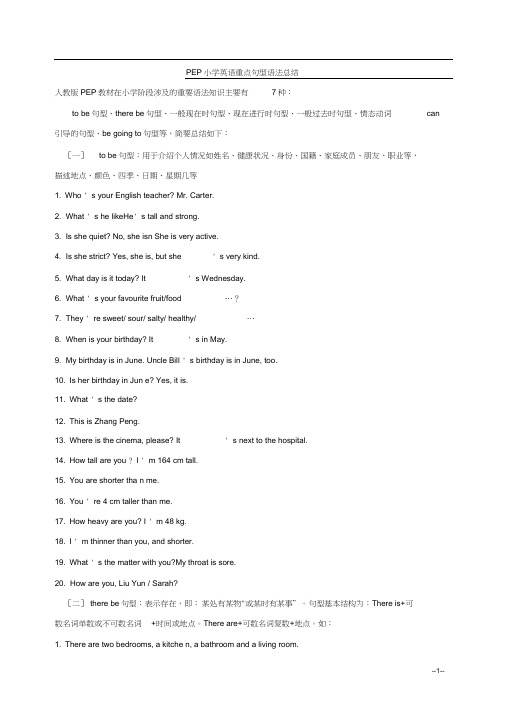
PEP小学英语重点句型语法总结人教版PEP教材在小学阶段涉及的重要语法知识主要有7种:to be句型、there be句型、一般现在时句型、现在进行时句型、一般过去时句型、情态动词can 引导的句型、be going to句型等,简要总结如下:[一]to be句型:用于介绍个人情况如姓名、健康状况、身份、国籍、家庭成员、朋友、职业等,描述地点、颜色、四季、日期、星期几等1. Who ' s your English teacher? Mr. Carter.2. What ' s he likeHe' s tall and strong.3. Is she quiet? No, she isn She is very active.4. Is she strict? Yes, she is, but she ' s very kind.5. What day is it today? It ' s Wednesday.6. What ' s your favourite fruit/food …?7. They ' re sweet/ sour/ salty/ healthy/ …8. When is your birthday? It ' s in May.9. My birthday is in June. Uncle Bill ' s birthday is in June, too.10. Is her birthday in Jun e? Yes, it is.11. What ' s the date?12. This is Zhang Peng.13. Where is the cinema, please? It ' s next to the hospital.14. How tall are you ? I ' m 164 cm tall.15. You are shorter tha n me.16. You ' re 4 cm taller than me.17. How heavy are you? I ' m 48 kg.18. I ' m thinner than you, and shorter.19. What ' s the matter with you?My throat is sore.20. How are you, Liu Yun / Sarah?[二] there be句型:表示存在,即:某处有某物"或某时有某事”。
小学三年级常用句型的英语语法总结
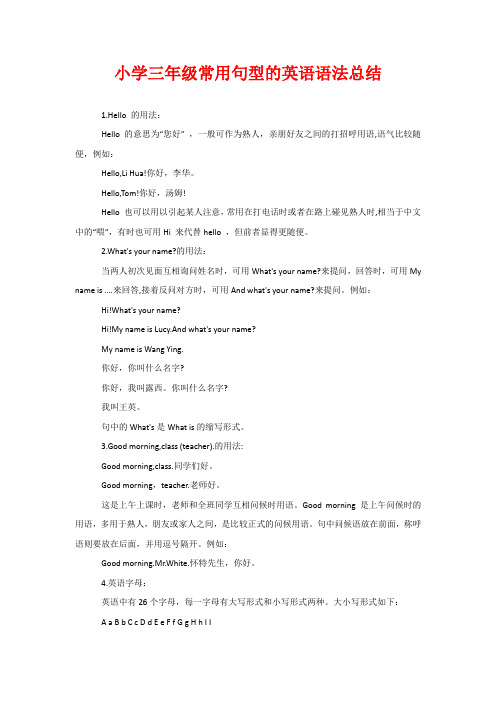
小学三年级常用句型的英语语法总结1.Hello 的用法:Hello 的意思为“您好” ,一般可作为熟人,亲朋好友之间的打招呼用语,语气比较随便,例如:Hello,Li Hua!你好,李华。
Hello,Tom!你好,汤姆!Hello 也可以用以引起某人注意,常用在打电话时或者在路上碰见熟人时,相当于中文中的“喂”,有时也可用Hi 来代替hello ,但前者显得更随便。
2.What's your name?的用法:当两人初次见面互相询问姓名时,可用What's your name?来提问,回答时,可用My name is ….来回答,接着反问对方时,可用And what's your name?来提问。
例如:Hi!What's your name?Hi!My name is Lucy.And what's your name?My name is Wang Ying.你好,你叫什么名字?你好,我叫露西。
你叫什么名字?我叫王英。
句中的What's是What is的缩写形式。
3.Good morning,class (teacher).的用法:Good morning,class.同学们好。
Good morning,teacher.老师好。
这是上午上课时,老师和全班同学互相问候时用语。
Good morning 是上午问候时的用语,多用于熟人,朋友或家人之间,是比较正式的问候用语。
句中问候语放在前面,称呼语则要放在后面,并用逗号隔开。
例如:Good morning.Mr.White.怀特先生,你好。
4.英语字母:英语中有26个字母,每一字母有大写形式和小写形式两种。
大小写形式如下:A aB bC cD dE eF fG gH hI IJ j K k L l M m N n O o P p Q q R rS s T t U u V v W w X x Y y Z z1.Are you…?的用法。
3~6年级英语重点句型及语法
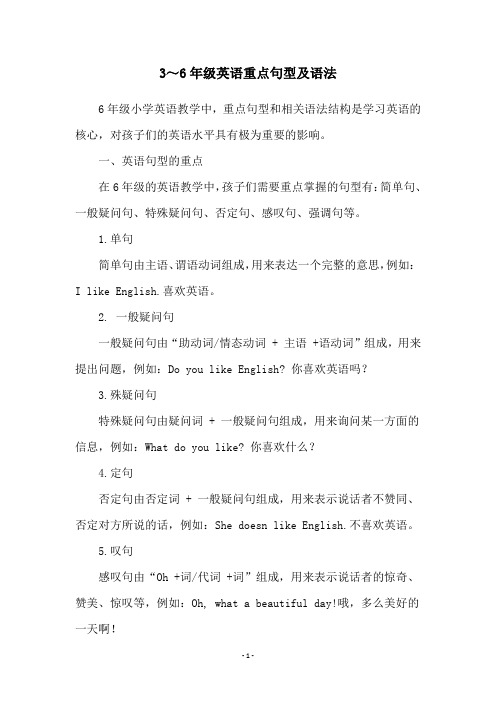
3~6年级英语重点句型及语法6年级小学英语教学中,重点句型和相关语法结构是学习英语的核心,对孩子们的英语水平具有极为重要的影响。
一、英语句型的重点在6年级的英语教学中,孩子们需要重点掌握的句型有:简单句、一般疑问句、特殊疑问句、否定句、感叹句、强调句等。
1.单句简单句由主语、谓语动词组成,用来表达一个完整的意思,例如:I like English.喜欢英语。
2. 一般疑问句一般疑问句由“助动词/情态动词 + 主语 +语动词”组成,用来提出问题,例如:Do you like English? 你喜欢英语吗?3.殊疑问句特殊疑问句由疑问词 + 一般疑问句组成,用来询问某一方面的信息,例如:What do you like? 你喜欢什么?4.定句否定句由否定词 + 一般疑问句组成,用来表示说话者不赞同、否定对方所说的话,例如:She doesn like English.不喜欢英语。
5.叹句感叹句由“Oh +词/代词 +词”组成,用来表示说话者的惊奇、赞美、惊叹等,例如:Oh, what a beautiful day!哦,多么美好的一天啊!6.调句强调句由“It is/was +强调部分 + that/who + 主句”组成,用来强调句子成分,例如:It is I who like English.我喜欢英语。
二、英语语法的重点6年级学生还需要掌握英语语法中的各类词类、时态、句子结构等:1.类词类学生们需要掌握单词、介词、动词、形容词、副词、代词、连词、冠词等英语语法的各类词类,以及其用法。
2.昀学生们要掌握现在时、过去时、将来时等不同时态的表达,了解它们的基本用法及区别。
3.子结构学生们要熟悉句子的简单结构、复合句的构成及连接词,能正确使用并分析句子。
三、综合练习在6年级学习英语时,综合练习也很重要,学生们可以利用实际情景,练习用英语表达句子,并能在日常对话中正确运用。
练习的方法可以是旁听英语对话,分析句子结构,以及反复练习句型,多种形式的练习将更容易帮助孩子们熟练掌握句型和语法。
小学二年级英语(上册)重点句型分类总结(精选)
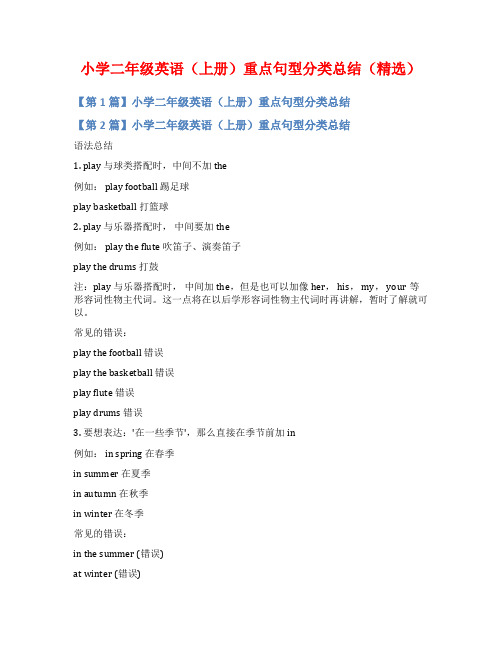
小学二年级英语(上册)重点句型分类总结(精选)【第1篇】小学二年级英语(上册)重点句型分类总结【第2篇】小学二年级英语(上册)重点句型分类总结语法总结1. play 与球类搭配时,中间不加the例如: play football 踢足球play basketball 打篮球2. play 与乐器搭配时,中间要加the例如: play the flute 吹笛子、演奏笛子play the drums 打鼓注:play 与乐器搭配时,中间加the,但是也可以加像her, his, my, your等形容词性物主代词。
这一点将在以后学形容词性物主代词时再讲解,暂时了解就可以。
常见的错误:play the football 错误play the basketball 错误play flute 错误play drums 错误3. 要想表达:'在一些季节',那么直接在季节前加in例如: in spring 在春季in summer 在夏季in autumn 在秋季in winter 在冬季常见的错误:in the summer (错误)at winter (错误)on autumn (错误)4. 要想表达:'在早、中、晚',那么用in the 再加上早中晚例如: in the morning 在早晨、在上午in the afternoon 在中午、在下午in the evening 在晚上常见的错误:in morning (错误)at afternoon (错误)in evening (错误)注: night 特殊,要用at例如: at night 在晚上5. 在几点钟前面要用at,无论是整点、半点、还是几点几分,都在时间前直接加at。
例如: at five o'clock 在五点at half past eleven 在十一点半at twelve ten 在十二点十分常见的错误:at the five o'clock 错误in half past ten 错误on the ten o'clock 错误6. 在城市、国家等大地点前面直接加in,并且城市、国家的首字母需要大写。
小学英语基本句型归纳
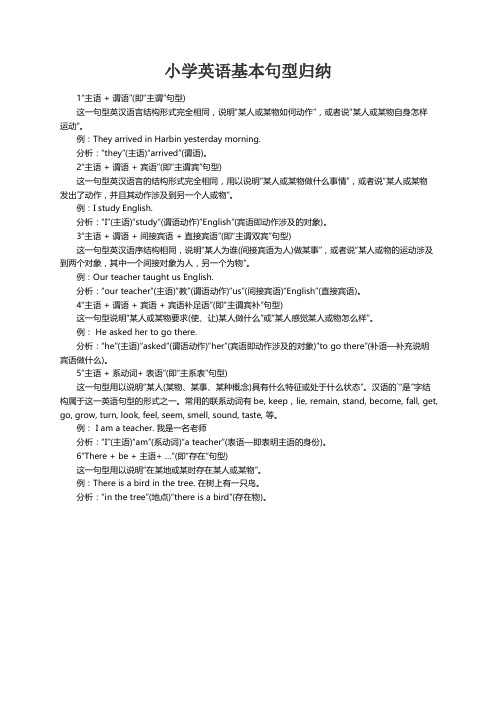
小学英语基本句型归纳1“主语 + 谓语”(即“主谓”句型)这一句型英汉语言结构形式完全相同,说明“某人或某物如何动作”,或者说“某人或某物自身怎样运动”。
例:They arrived in Harbin yesterday morning.分析:“they”(主语)“arrived”(谓语)。
2“主语 + 谓语 + 宾语”(即“主谓宾”句型)这一句型英汉语言的结构形式完全相同,用以说明“某人或某物做什么事情”,或者说“某人或某物发出了动作,并且其动作涉及到另一个人或物”。
例:I study English.分析:“I”(主语)“study”(谓语动作)“English”(宾语即动作涉及的对象)。
3“主语 + 谓语 + 间接宾语 + 直接宾语”(即“主谓双宾”句型)这一句型英汉语序结构相同,说明“某人为谁(间接宾语为人)做某事”,或者说“某人或物的运动涉及到两个对象,其中一个间接对象为人,另一个为物”。
例:Our teacher taught us English.分析:“our teacher”(主语)“教”(谓语动作)“us”(间接宾语)“English”(直接宾语)。
4“主语 + 谓语 + 宾语 + 宾语补足语”(即“主谓宾补”句型)这一句型说明“某人或某物要求(使、让)某人做什么”或“某人感觉某人或物怎么样”。
例: He asked her to go there.分析:“he”(主语)“asked”(谓语动作)“her”(宾语即动作涉及的对象)“to go there”(补语—补充说明宾语做什么)。
5“主语 + 系动词+ 表语”(即“主系表”句型)这一句型用以说明“某人(某物、某事、某种概念)具有什么特征或处于什么状态”。
汉语的`“是”字结构属于这一英语句型的形式之一。
常用的联系动词有be, keep,lie, remain, stand, become, fall, get, go, grow, turn, look, feel, seem, smell, sound, taste, 等。
- 1、下载文档前请自行甄别文档内容的完整性,平台不提供额外的编辑、内容补充、找答案等附加服务。
- 2、"仅部分预览"的文档,不可在线预览部分如存在完整性等问题,可反馈申请退款(可完整预览的文档不适用该条件!)。
- 3、如文档侵犯您的权益,请联系客服反馈,我们会尽快为您处理(人工客服工作时间:9:00-18:30)。
PEP小学英语重点句型语法总结与分析三年级起点的人教版PEP教材在小学阶段共有8册书,其涉及的重要语法知识主要有7种:to be句型、there be句型、一般现在时句型、现在进行时句型、一般过去时句型、情态动词can引导的句型、be going to句型等。
现以5——8册书为例,简要分析如下:[一] to be句型:用于介绍个人情况如姓名、健康状况、身份、国籍、家庭成员、朋友、职业等,描述地点、颜色、四季、日期、星期几等,该句型广泛分布于各册教材中,其中5——8册的句型主要有:1. Who's your English teacher? Mr. Carter.2. What's he like? He's tall and strong.3. Is she quiet? No, she isn't. She is very active.4. Is she strict? Yes, she is, but she's very kind.5. What day is it today? It's Wednesday.6. What's your favourite fruit/food…?7. They're sweet/ sour/ salty/ healthy/…8. When is your birthday? It's in May.9. My birthday is in June. Uncle Bill's birthday is in June, too.10. Is her birthday in June? Yes, it is.11. What's the date?12.This is Zhang Peng.13. Where is the cinema, please? It's next to the hospital.14. How tall are you? I'm 164 cm tall.15. You are shorter than me.116.You're 4 cm taller than me.17.How heavy are you? I'm 48 kg.18. I'm thinner than you, and shorter.19. What's the matter with you? My throat is sore.20. How are you, Liu Yun / Sarah?[二] there be句型:表示存在,即:“某处有某物”或“某时有某事”。
句型基本结构为:There is+ 可数名词单数或不可数名词+时间或地点。
There are+可数名词复数+地点。
该句型主要分布在第5册的Unit 5和Unit 6中,如:1. There are two bedrooms, a kitchen, a bathroom and a living room.2. There is a mirror, a bed and a big closet.3. Is there a forest in the park? Yes, there is.4. Is there a river? No, there isn't.5. Are there any pandas in the mountains? No, there aren't.6. Are there any fish in the rivers? Yes, there are.[三] 一般现在时句型:表示习惯性的动作或行为,或现在存在着的状况。
句型基本结构为:主语+行为动词+其他。
当主语是第三人称单数时,要在动词原形后面加s或es,其他人称作主语时则用动词原形,在问句及否定句中需要用助动词do或does。
这种句型通常有一些标志词,如:usually often sometimes never always等。
该句型主要分布在第5册Unit2&3,第6册Unit1&2, 第7册Unit4,5,6, 第8册Unit2中。
如:Book5:1. What do you have on Thursdays? We have English, math and science onThursdays.2. What do you do on Saturdays? I watch TV on Saturdays.23. I do my homework.4. What do you have for lunch on Mondays? We have tomatoes, tofu and fish.5. I like fruit. But I don't like grapes.Book6:1. When do you eat dinner? I eat dinner at 7:00 in the evening.2. When do you get up? I usually get up at 12:00 noon.3. What do you do on the weekend? Usually I watch TV and go shopping.4. Sometimes I visit my grandparents. I often play football. Sometimes I gohiking.5. Which season do you like best? I like winter best.6. Why do you like summer/winter?Book7:1. How do you go to school, Sarah?2. Usually I go to school on foot. Sometimes I go by bike.3. I like collecting stamps. He likes collecting stamps, too.4. Does she teach math? Yes, she does.5. Does she teach English? No, she doesn't. She teaches math.6. What does your mother do? What does your father do?7. Where does she work? She works in a car company.8. How does she go to work? She goes to work by bus.9. Where does the rain come from? It comes from the clouds.10. Where does the cloud come from? It comes from the vapour.11. Where does the vapour come from? It comes from the water in the river.312. The sun shines and the water becomes vapour.13. How do you do that?Book8:1. My nose hurts.2. How do you feel? I feel sick. How does Amy feel?3. You look so happy. You look sad today.[四] 现在进行时句型:表示说话时正在进行的动作或事件,或在短期内正在进行的动作或存在的情况。
标志词是:now 也常用在Look! Listen!等后面。
句型主要结构为:be动词(am, is, are)+动词现在分词(v. ing)。
该句型主要分布在第6册Unit4, 5,6中。
如:1. What are you doing? I'm doing the dishes. I'm reading a book.2. Grandpa is writing a letter. Brother is doing homework. Mom is cookingdinner in the kitchen.3. He is writing an e-mail in the study.3. What is it doing ? It's eating bananas.4. What is she doing ? She's jumping.5. What are they doing ? They're swimming. They' re climbing trees.6. Are you eating lunch? No, we aren't.7. Are they eating the honey? Yes, they are.8. Is he playing chess? Yes, he is.9. Is she counting insects? No, she isn't.[五] 一般过去时句型:表示过去发生的而现在已经结束的事件、动作或情况。
句型基本结构为:主语+动词过去式+其他。
标志词通常是:yesterday, last week , lastyear 等,在问句与否定句中要用助动词did。
该句型分布在第8册Unit3&4中。
如:41.What did you do last weekend? I played football.2. Did you help them clean their room? Yes, I did.3.What did you do yesterday? I went fishing.4. Did you read book? Yes, I did.5. Did you clean your room? No, I didn't.6.Where did you go on your holiday? I went to Xinjiang.7. What did you do there? I sang and danced with my new friends.8. How did you go there? I went by train.此外,一般过去时也可用来表示客气的询问。
